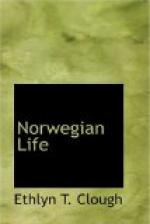The secondary schools are maintained by the state, and are confined to the towns. They comprise nine forms in seven classes, of which the last two have double forms. The first three correspond to the curriculum of the primary schools, where are taught reading, writing, arithmetic, history, natural sciences, singing, drawing, and gymnastics, to which are added Sloyd and gardening for the boys, and needlework and cooking for the girls. Scholars who have passed these in the primary schools enter into the fourth form. They are generally divided into two branches, the classical and the modern, according as the classics or languages predominate in the curriculum, which comprises religion, Swedish composition, history, geography, philosophy, Latin, Greek, German, French, mathematics, zoology, botany, physics, chemistry, and drawing. After the fourth form, pupils must declare, with the written approbation of their parents or guardians, whether they will follow the classical or non-classical course, according as they intend to qualify for the universities or the technical high schools. Not all the pupils who attend these secondary schools complete the full course and pass the final examination. More than half—those who mean to devote themselves to trade, agriculture, or industry, and those who have not developed the capabilities necessary to confront the severe final test of the “maturity” examination—leave the school on attaining the upper forms. To those who intend to enter the professions, the civil and military service, and the church, the full course of the secondary school is necessary, the “maturity” examination certificate being the only open sesame to the universities, the special colleges, and the technical high schools. To obtain it and to don the white cap, which is the outward and visible sign of university membership, is the first great step in the life of the ambitious youth.




